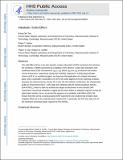Adiabatic Solid Effect
Author(s)
Tan, Kong Ooi; Weber, Ralph T.; Can, Thach V.; Griffin, Robert G.
DownloadAccepted version (1.103Mb)
Open Access Policy
Open Access Policy
Creative Commons Attribution-Noncommercial-Share Alike
Terms of use
Metadata
Show full item recordAbstract
The solid effect (SE) is a two spin dynamic nuclear polarization (DNP) mechanism that enhances the sensitivity in NMR experiments by irradiation of the electron-nuclear spin transitions with continuous wave (CW) microwaves at ω0S ± ω0I, where ω0S and ω0I are electron and nuclear Larmor frequencies, respectively. Using trityl (OX063), dispersed in a 60/40 glycerol/water mixture at 80 K, as a polarizing agent, we show here that application of a chirped microwave pulse, with a bandwidth comparable to the EPR line width applied at the SE matching condition, improves the enhancement by a factor of 2.4 over the CW method. Furthermore, the chirped pulse yields an enhancement that is ∼20% larger than obtained with the ramped-amplitude NOVEL (RA-NOVEL), which to date has achieved the largest enhancements in time domain DNP experiments. Numerical simulations suggest that the spins follow an adiabatic trajectory during the polarization transfer; hence, we denote this sequence as an adiabatic solid effect (ASE). We foresee that ASE will be a practical pulsed DNP experiment to be implemented at higher static magnetic fields due to the moderate power requirement. In particular, the ASE uses only 13% of the maximum microwave power required for RA-NOVEL.
Date issued
2020-04Department
Francis Bitter Magnet Laboratory (Massachusetts Institute of Technology); Massachusetts Institute of Technology. Department of ChemistryJournal
Journal of Physical Chemistry Letters
Publisher
American Chemical Society (ACS)
Citation
Tan, Kong Ooi, Weber, Ralph T, Can, Thach V and Griffin, Robert G. 2020. "Adiabatic Solid Effect." Journal of Physical Chemistry Letters, 11 (9).
Version: Author's final manuscript
ISSN
1948-7185